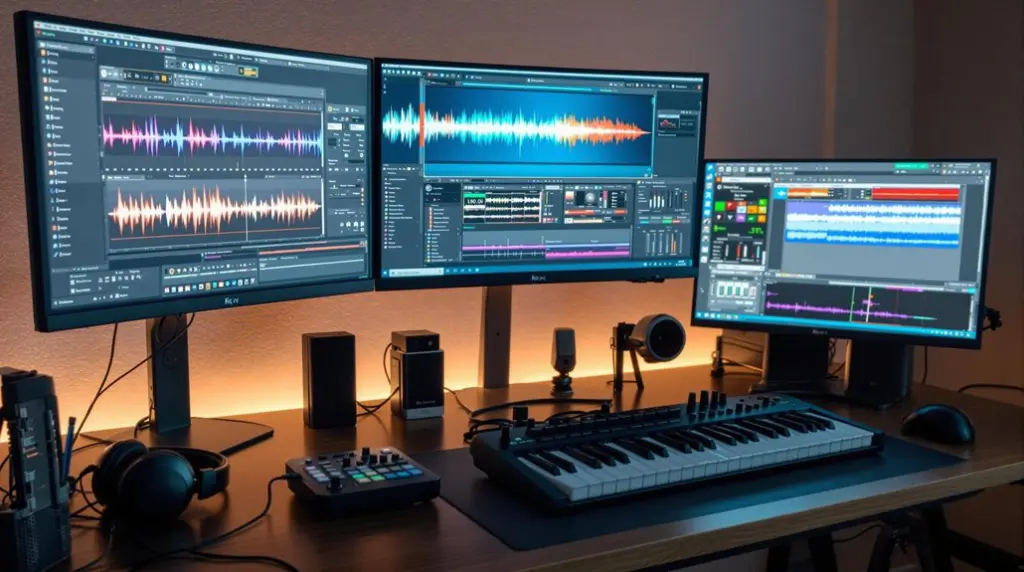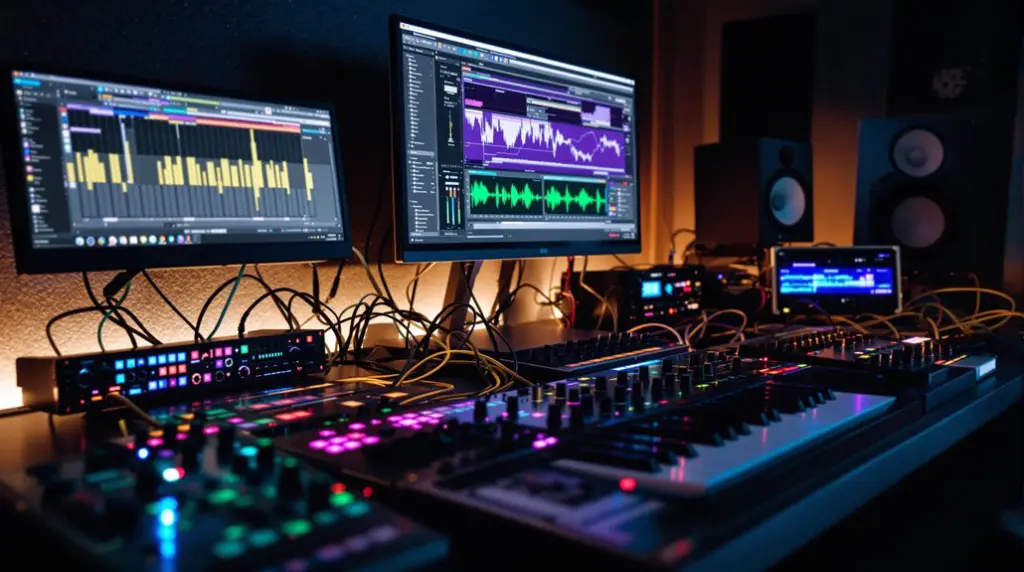The Access Virus A synthesizer excels with its top-tier design and build quality, featuring a compact, intuitive interface with numerous controls for dynamic sound manipulation. It boasts powerful oscillator capabilities, offering a mix of analog and digital waveforms and robust modulation options, including three LFOs and a modulation matrix. The filter section is equally advanced, with programmable dual-resonant filters and flexible routing. Performance features like 16-part multitimbrality and MIDI support add versatility, while thorough connectivity options guarantee seamless integration into any setup. Its extensive effects and processing capabilities empower intricate soundscapes and real-time modulations. Explore deeper to uncover its full potential.
Key Takeaways
- Oscillator Versatility: Offers 12 voices with dual oscillators, classic analog shapes, and 64 digital waveforms for extensive sound design.
- Advanced Filter Section: Dual-resonant filters with low-pass, high-pass, band-pass, and notch configurations, plus series or parallel routing.
- Comprehensive Modulation: Three LFOs, modulation matrix, and envelope mode for intricate and unique sound modulation.
- Dynamic Envelope Shaping: Two envelope generators with detailed parameters and additional punch for impactful transients.
- Superior Connectivity: MIDI integration, three stereo audio outputs, and a stereo input for external audio processing.
Design and Build Quality
With respect to design and build quality, the Access Virus A synthesizer exemplifies meticulous engineering and robust construction. The compact tabletop design, with dimensions of 18.5 x 7 x 2.5 inches, guarantees that it is versatile enough for both studio and performance settings. This form factor facilitates considerable portability without compromising on functionality or structural integrity.
The user interface design is a standout feature, equipped with 32 knobs, 27 switches, and 52 LEDs. This array allows for intuitive sound manipulation and real-time control, enhancing the user experience notably. The logical panel arrangement groups related functions—such as oscillators, filters, and modulation controls—together, which streamlines the user experience by making navigation and sound design more efficient during live performances or intricate programming sessions.
Additionally, the intuitive interface can be an essential component for critical listening during sound design, guaranteeing that every tweak and adjustment is done with precision. Moreover, the 2-line x 16-character backlit display guarantees clear visibility, making it easier to program and navigate through different settings even in low-light conditions.
Constructed with high-quality materials, the Virus A is built to last, offering durability and resilience in diverse environments. This synthesis of design precision and robust build quality guarantees that the Access Virus A remains a reliable tool in any electronic musician’s arsenal.
Oscillator Capabilities
A cornerstone of the Access Virus A synthesizer’s sonic prowess lies in its oscillator capabilities, which are both versatile and powerful. Each of its 12 voices boasts two oscillators, offering a rich array of waveform variety, including classic analog shapes such as sawtooth and square waves, as well as 64 digitally-stored waveforms. This extensive selection provides sound designers with a robust foundation for creating diverse and intricate sound textures.
The software capabilities of the Virus A align well with versatile sound libraries, encouraging experimentation and sound refinement. The Virus A further enhances sound complexity through multiple modulation parameters such as frequency modulation (FM) amount, detune, and semitone adjustments. These features allow for precise control over the tonal characteristics and harmonic content of each oscillator, enabling the synthesis of complex timbres.
The WaveShape knob is particularly remarkable, facilitating seamless changes between digital waveforms and traditional analog shapes, thereby expanding the sonic palette available to the user.
Additionally, the synthesizer’s oscillator architecture includes a sub-oscillator, which contributes substantial low-end presence, essential for crafting rich bass patches. The Twin Mode feature, by allocating two voices per note, effectively doubles the sound depth, although it reduces polyphony to six notes. This trade-off underscores the Virus A’s commitment to delivering profound sound depth and complexity.
Filter Section
The filter section of the Access Virus A synthesizer stands out due to its programmable dual-resonant filters, which offer exceptional versatility for sound shaping and design. This section incorporates two independent resonant filters that support various types such as low-pass, high-pass, band-pass, and notch configurations.
These multiple filter types cater to a wide range of sonic preferences, allowing for intricate sound sculpting. One of the standout features of the Access Virus A’s filter section is its flexible filter routing. The filters can be connected either in series or parallel, enabling users to achieve complex signal paths and enhance sound texture considerably.
This dual-routing capability, combined with up to 6-pole filter operation, provides a rich palette for sound designers to explore. Additionally, the filter saturation feature is significant. By introducing harmonic distortion, filter saturation enriches the overall sound character, adding warmth and depth.
The realistic resonance capabilities further heighten the filters’ expressiveness, enabling dramatic sweeps and dynamic modulations. Given its high-quality mix fundamental for mastering, this makes the Access Virus A’s filter section not only versatile but also powerful in crafting intricate and evolving soundscapes.
This level of control and flexibility is essential for professionals seeking to push the boundaries of their sonic creativity.
Modulation Options
The Access Virus A synthesizer offers robust modulation options with its three LFOs, which can be assigned to modulate parameters such as pitch, waveshape, and filter cutoff, enabling intricate sound design possibilities.
Each LFO can operate in polyphonic or monophonic mode and features a variety of waveforms, such as triangle, sawtooth, and sample and hold, providing flexibility for dynamic modulation effects.
In addition, the modulation matrix and envelope mode expand these capabilities, allowing complex routing and unique one-shot envelopes for dynamic, real-time sound shaping.
Additionally, AI-enhanced sound design tools, like Synplant 2, are now making advanced sound manipulation more intuitive, further enhancing the creative potential of synthesizers like the Access Virus A.
LFO Versatility
Exploring the LFO versatility of the Access Virus A synthesizer reveals a robust modulation framework that greatly enhances sound design capabilities. The Access Virus A features three LFOs, each capable of modulating various parameters such as pitch, resonance, and filter cutoff, consequently providing vast modulation options. The modulation depth and range of LFO shapes available enable intricate and expressive sound sculpting.
Each LFO can operate in polyphonic or monophonic modes, offering flexibility for both layered textures and single-note performances. LFO 1 can be configured to control pitch, pulse width, and filter gain, while LFO 2 modulates waveshape and FM amount, introducing a higher level of complexity to sound creation. Additionally, the LFOs can function as one-shot envelopes when switched to Envelope Mode, allowing for unique modulation effects that mimic envelope shaping. The Key Follow functionality on the LFOs further enhances modulation speed adjustment based on the keyboard note played, adding a dynamic and responsive element to live performances.
| LFO Number | Modulated Parameters |
|---|---|
| LFO 1 | Pitch, Pulse Width, Filter Gain |
| LFO 2 | Waveshape, FM Amount |
| LFO 3 | Pitch, Resonance, Cutoff |
| All LFOs | Envelope Mode, Key Follow |
These advanced features make the Access Virus A a powerhouse for sound designers seeking versatile and dynamic modulation options.
Envelope Flexibility
Building on the robust LFO capabilities, the envelope flexibility of the Access Virus A synthesizer offers another layer of profound modulation potential. The unit features two envelope generators specifically designed to control both the filter section and the VCA level, providing users with the ability to meticulously sculpt sound characteristics.
Each envelope can be shaped with five key parameters: Attack, Decay, Sustain, Time, and Release, enabling extensive envelope shaping that accommodates a wide array of sound design needs.
The inclusion of a Punch parameter further enhances these envelopes by injecting a percussive kick, thereby expanding the modulation depth and potential for dynamic sound creation. This feature is invaluable for producing sharp, impactful transients that can stand out in a mix.
Moreover, the envelopes can be utilized in conjunction with the LFOs, resulting in complex modulation setups that can emulate the fluidity of analog synthesizers. This synthesis flexibility is augmented by the modular routing capabilities, allowing the envelopes to modulate various parameters such as pitch and filter cutoff.
This makes it straightforward to achieve intricate and evolving sounds, making the Access Virus A an exceptionally versatile tool for sound designers and musicians seeking dynamic modulation options.
Effects and Processing
The Access Virus A synthesizer’s effects and processing capabilities are robust, featuring flexible delay options that allow for precise temporal manipulation of audio signals.
Its versatile chorus parameters offer a wide range of modulation possibilities, enriching the harmonic content and spatial characteristics of the sound.
Additionally, the realistic resonance filters provide an authentic analog warmth, essential for achieving nuanced and dynamic tonal textures.
Flexible Delay Options
When it comes to enhancing rhythmic elements and adding depth to sound patches, the Access Virus A’s flexible delay processor stands out as an important feature. The delay customization capabilities of this synthesizer allow users to finely tune parameters such as feedback and delay time, thereby tailoring the echo effects to fit a wide array of audio textures.
This level of control is vital for achieving precise rhythmic enhancement in any musical context.
The Access Virus A offers multiple types of delay effects, making it versatile enough to cater to various sound design needs and musical styles. Whether aiming for a simple slapback echo or a more complex, evolving delay pattern, this synthesizer delivers.
Additionally, the ability to sync the delay effect to the project’s tempo guarantees that all rhythmic elements are perfectly aligned with the musical structure, thereby maintaining coherence in the overall composition.
These flexible delay options greatly contribute to the Virus A’s reputation for creating intricate and engaging audio landscapes. By offering such a high degree of delay customization, the Access Virus A empowers sound designers and musicians to explore and craft unique sonic environments with unparalleled precision.
Versatile Chorus Parameters
Among the array of modulation effects offered by the Access Virus A, its versatile chorus parameters stand out due to their extensive adjustability and profound impact on sound design. The synthesizer’s chorus effect, with adjustable parameters such as depth, rate, and feedback, provides sound designers with tools to intricately modulate their audio output.
This flexibility allows users to implement a wide range of chorus techniques that can greatly alter the spatial characteristics of individual sounds or patches, particularly in Single Mode.
The Access Virus A’s Multi Mode enhances this capability by supporting global delay and up to four simultaneous chorus effects, resulting in a richer and more complex sound palette. The ability to fine-tune chorus settings enables sound designers to create effects that range from subtle thickening to pronounced detuning, catering to various musical genres and modulation styles.
Key features of the Access Virus A chorus parameters include:
- Adjustable depth, rate, and feedback for precise control.
- Single Mode application for individual sound enhancement.
- Multi Mode application for complex, global modulation.
- Versatility in creating subtle to pronounced detuning effects.
These features underscore the Access Virus A’s prowess in producing lush, dynamic soundscapes, especially beneficial for pads and leads.
Realistic Resonance Filters
Access Virus A’s resonant filter section exemplifies advanced sound manipulation capabilities, featuring two independent resonant filters capable of various types, including low-pass and high-pass configurations. These filters can be arranged in either series or parallel modes, allowing for intricate sound shaping and achieving up to 6-pole operation.
This flexibility in filter types provides a broad spectrum of sonic textures, from smooth shifts to aggressive resonance effects. The inclusion of saturation control within the filter section introduces a layer of distortion, enriching the sound palette with harmonic complexity. This feature enhances the overall tonal character, making the Virus A suitable for both subtle and extreme sonic alterations.
Additionally, the integration of envelope modulation offers dynamic control over filter cutoff and resonance parameters, enabling expressive sound manipulation that responds to performance nuances. Highly resonant filter designs are a hallmark of the Virus A, capable of producing aggressive overdrive effects.
This attribute is particularly beneficial in creating unique, cutting-edge sounds that stand out in a mix. The combination of versatile filter types, saturation control, and envelope modulation positions the Access Virus A as a powerful tool for sound designers seeking both precision and creativity in their audio production endeavors.
Performance Features
The Access Virus A synthesizer excels in performance features through its meticulously designed two-tiered programming interface, which enables swift access to essential parameters via an array of 32 knobs, complemented by an LCD menu system for in-depth sound sculpting.
This design facilitates seamless shifts during live performance, allowing musicians to adjust settings on the fly while maintaining focus on their craft. Additionally, the tactile interface guarantees user-friendly operation with quick access to dynamics control and stereo field management for enhanced live sound.
Key elements that empower the Virus A in live settings include:
- 16-part multitimbrality: This feature allows for sophisticated sound layering, enabling artists to deploy multiple patches simultaneously, thereby enriching the sonic texture.
- Basic arpeggiator: With multiple playing modes (up, down, up & down) and a dedicated clock generator, the arpeggiator guarantees precise rhythmic patterns, essential for dynamic performances.
- MIDI capabilities: Every knob transmits MIDI control changes, ensuring the synthesizer can seamlessly integrate into a broader MIDI setup, enhancing control precision.
- Tactile interface: The 32 knobs, 27 switches, and 52 LEDs provide an engaging, hands-on experience, essential for real-time adjustments during performances.
The combination of these features makes the Access Virus A a robust tool for live performance, allowing for intricate sound layering and immediate control over a vast array of parameters.
Connectivity and Integration
Seamless connectivity and robust integration capabilities are essential for synthesizers in modern music production environments, and the Access Virus A excels in this regard. The unit’s MIDI communication prowess is evident through its inclusion of MIDI In and Out sockets, which facilitate effortless interaction with other MIDI devices and controllers. This guarantees that the Virus A can be easily incorporated into existing MIDI setups, enhancing workflow efficiency.
Moreover, the synthesizer’s audio routing flexibility is a significant advantage. With three stereo audio outputs, users can route distinct sounds and effects to separate channels in a mixing environment, providing greater control over the audio landscape. This feature is particularly beneficial for complex productions requiring meticulous sound separation and processing.
Additionally, the Access Virus A’s compatibility with popular digital audio workstations like Ableton Live and Logic Pro X guarantees seamless workflow integration. The integration extends further with the Virus A’s stereo input, which supports external audio processing. This allows users to manipulate external signals in conjunction with the synthesizer’s internal sounds, offering expansive creative possibilities.
Compatibility with various DAWs and VST/AU plugins ensures that the Access Virus A can be seamlessly integrated into modern digital audio workstations, enhancing its utility in contemporary production settings.
While the external 12V adapter may affect portability, it guarantees stable power supply, vital for both studio and live performance reliability.
Frequently Asked Questions
Is Access Virus Still Relevant?
The Access Virus remains relevant in contemporary music production, particularly for electronic genres. Its enduring appeal lies in its robust sound design capabilities, advanced performance techniques, and significant role in the evolution of virtual instruments and synthesizers.
Is Access Virus Analog?
The Access Virus is not a true analog synthesizer; it employs digital synthesis to emulate analog sounds. Utilizing digitally-stored waveforms and advanced processing, it delivers a hybrid synthesis experience that combines the best of both worlds.
What Is Key Follow on a Synthesizer?
Key Follow on a synthesizer enables modulation parameters to be influenced by the pitch of notes, enhancing expressiveness. Key Follow benefits include dynamic sound variation and musical relevance, with applications in evolving textures and cohesive melody-modulation relationships.
What Is Key Follow on a Synthesizer?
Key Follow modulation on a synthesizer adjusts parameters like pitch and filter cutoff based on the note played, creating dynamic sound variations. This feature enhances expressiveness, allowing for intricate key follow effects essential in electronic music production.
Conclusion
The Access Virus synthesizer exemplifies advanced design and robust build quality, offering exceptional oscillator capabilities and a versatile filter section. Its extensive modulation options and high-quality effects processing enhance its sonic versatility. Performance features are meticulously engineered to facilitate live and studio use, while thorough connectivity and integration options guarantee compatibility with diverse setups. Overall, the Access Virus synthesizer stands out as a powerful tool for professional sound designers and musicians seeking unparalleled creative potential.




